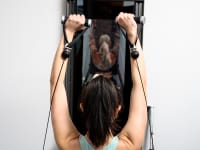I tried the under-desk elliptical with over 1,000 reviews—is it worth it?
If something seems too good to be true, it probably is.
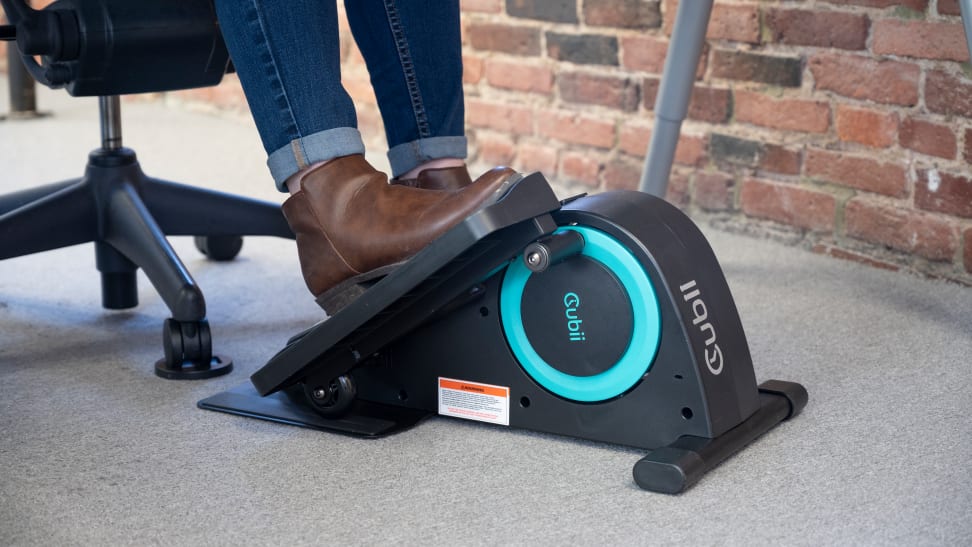 Credit:
Reviewed / Betsey Goldwasser
Credit:
Reviewed / Betsey Goldwasser
Products are chosen independently by our editors. Purchases made through our links may earn us a commission.
Do you ever go your whole work day without moving from your desk, except for maybe a lunch break ... that also involves sitting? If you answered yes, maybe you’ve also tried to think of ways to implement more exercise, or even just movement, into your daily routine.
You’re not alone in this desire—in fact, that’s why the wildly popular Cubii Jr., an under-desk elliptical, was invented. But can a product that encourages—er, requires—you to be seated actually help you stay fit? We put it to the test to find out.
What is the Cubii Jr.?
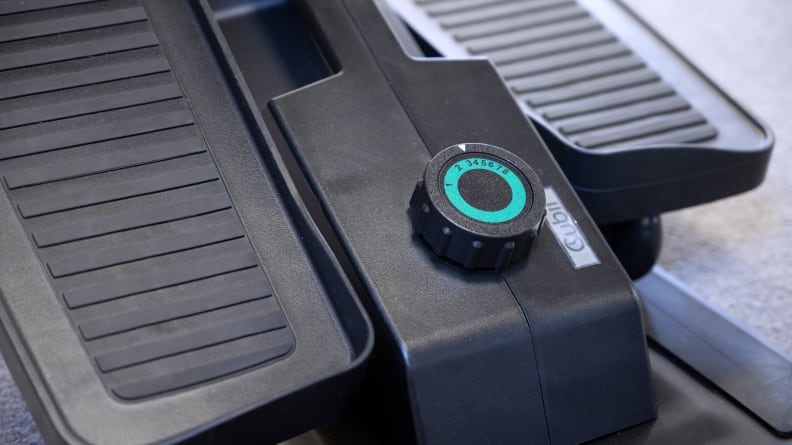
The Cubii Jr. has eight resistance settings.
The $249 Cubii Jr. is an under-desk elliptical machine that allows you to pedal your feet while you work at a computer, ostensibly to allow you to exercise despite being seated. The bulk of the device is composed of two pedals not unlike the pedals on a standard upright elliptical you’d find at any gym. It has eight resistance levels that increase via a dial on the machine. There’s also a small screen that displays your calories, strides, distance, and RPM (“revolutions” or strides per minute, in this case), and a handle for transporting the machine. It comes with hockey puck-sized chair anchors that fit most office chair wheels to keep your seat from rolling around as you pedal.
The name “junior” is because the company also makes the $349 Cubii Pro, which has a Bluetooth feature that allows you to sync the data to your iPhone or Android and track stats on apps like Fitbit and Apple Health Kit. We chose to test the Cubii Jr. because it’s the more popular of the two, with 1,786 Amazon reviews and a 4.7-star rating at the time of this review, compared to the Pro’s 872 reviews and 4.3-star rating.
How easy is the Cubii Jr. to set up?
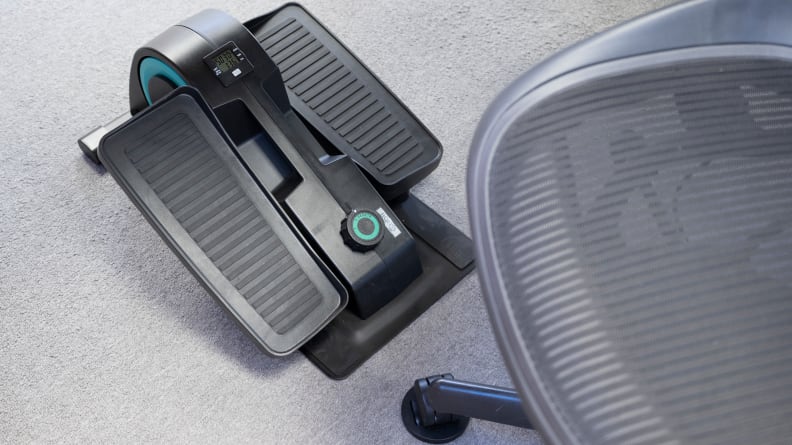
The Cubii Jr. comes with anchors for a rolling desk chair.
At about 27 pounds, the Cubii Jr. is surprisingly heavy for something that you may move around to the different places you sit at home (its advertisements depict people using it in an office and living room). I experienced back pain earlier this year and am concerned I could re-injure myself, so a coworker carried the Cubii Jr. to my desk and was nice enough to set it up for me, which only took four screws and a screwdriver, all of which were provided. He said the setup was intuitive, but he read the instructions out of caution and found them easy to follow. The whole setup took less than five minutes.
Once assembled, I scooted the Cubii under my office desk. I found positioning the chair anchors intuitive, though it took some finagling to get them in the right spots so I could roll my chair wheels up and onto them and lock into place.
What does the Cubii Jr. claim to do?
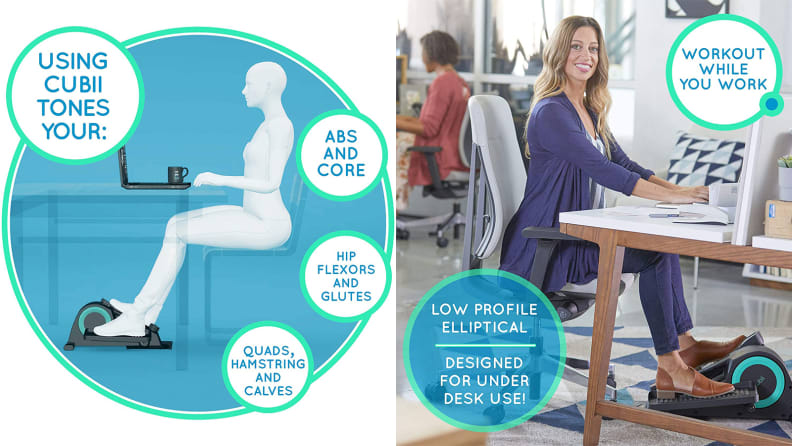
The Cubii Jr. claims to get you fit while you sit, whether it's at home or work.
The big bold-faced claim is that this device allows you to “get fit while you sit,” helping you “burn calories from your couch” and “lose weight and get in shape” while toning your abs, core, hip flexors, glutes, quads, hamstrings, and calves in the process.
Cubii also says that, because the machine is low impact on the joints, it should become an “unconscious” form of fitness, which I interpret to mean that it won’t distract you to pedal while you type. If anything, I’d think this might help you focus on your computer tasks by providing your fidgety tendencies an outlet.
Finally, Cubii claims to be “perfect for home rehabilitation” because it’s “low impact” with eight resistances that you can cater to your abilities.
Aside from what it can do for you, the Cubii claims to be noiseless, so it won’t distract or irritate coworkers, family, or anyone else within earshot.
How did we test the Cubii Jr.?
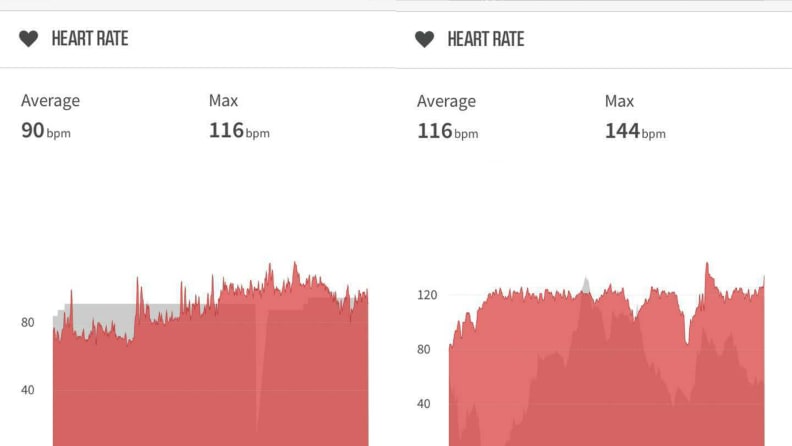
My maximum heart rate while using the Cubii was my average heart rate while walking.
As Reviewed’s lifestyle writer and someone who sits at a desk from 9 a.m. to 5 p.m., I was curious about Cubii’s claims. I grew up relatively fit with soccer practice and dance classes multiple times a week, but without those recreational activities in place now that I’m in my 20s, I’m still striving to implement regular exercise in my routine. I try to walk about an hour a day and I occasionally take exercise classes, like spin or yoga. I wouldn’t call myself a Fitness Queen by any means, but I do my best to treat my body well along the way. I had to go to physical therapy for an inflamed disk in my back, which limited me in the last year, though I’ve since been cleared for regular exercise.
My tests fell into two categories: passive and active testing. The former involved testing the Cubii Jr. as any other customer would: I pedaled when the mood struck and didn’t use it (or stopped) when I found it distracting to my work or uncomfortable. For example, I learned that tight jeans are too restrictive for pedaling and the fabric can chafe as your legs pump up and down. I used the Cubii during work hours for a few weeks, collecting my thoughts and jotting down notes.
Once I felt like my opinion was solidified about how the Cubii fit into my everyday routine, I conducted a set of active tests, designed with the help of Reviewed editor Amy Roberts, who is also a certified personal trainer.
Because this product makes a number of fitness claims, we purchased a heart rate monitor to gauge its efficacy. To set a baseline for my effort during a low-impact activity, I wore the heart rate monitor and walked around the neighborhood near the office for 24 minutes—about how long it takes to do my usual lunchtime loops—at my typical brisk pace, with a few moments where I picked it up (say, to cross the street before the light changed or to bop to an upbeat song).
Hours later, I sat down at my desk and tried the following sequence with the heart rate monitor on. First, I just worked at my computer for 10 minutes, to determine my resting heart rate while doing usual tasks. Then I used the Cubii for a total of 30 minutes, in the following ways:
- I put the Cubii on the lightest resistance and pedaled casually for 10 minutes.
- I put the Cubii on the highest resistance and pedaled for 10 minutes.
- I pedaled fast for five minutes at a resistance that felt comfortable for this (I ended up on level five of the eight).
- I pedaled as fast as I could with an elevated resistance (level seven out of eight) for five minutes.
Does the Cubii Jr. do what it claims?
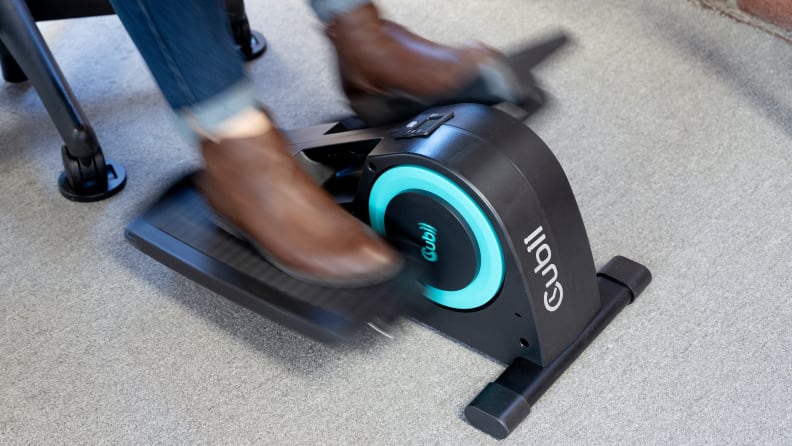
I put the Cubii Jr. under my work desk for testing.
Let’s tackle the noiseless claim first, which Cubii aced. While you may hear the slight swishing of the pedals, it’s predominantly noise-free, and my coworkers will back me up on that. In fact, I chatted with Reviewed’s editor-in-chief Dave Kender who stopped by my desk while I was pedaling away, and when I mentioned I was testing as we spoke, he said he had no idea and thought I was just particularly fidgety that day (my torso sways in response to my legs pumping).
While the Cubii doesn’t distract those around me, using it shifted my attention away from my work. I found it impossible to idly pedal at any resistance, but especially if I wanted to get some exercise out of it. I ended up paying more attention to how fast I could pedal or whether or not I could pedal the same speed with a higher resistance—no matter what, there’s no way I’d call the Cubii a passive activity for work hours.
Not only was it distracting, but it was downright awkward at times. The range of motion is very shallow, so you don’t build momentum from pushing down hard and having the pedal swing back up at you, in the way you would with a bicycle or a full-size standing elliptical. I found this to be the case even when I was sitting perched on the edge of my seat with my chair pulled as close as it could be to the machine to try to get right up over it. When I wasn’t doing that, pedaling the Cubii wasn’t even engaging my larger leg muscles; it was more like an ankle exercise.
We also found that the fitness claims Cubii makes, based on the heart rate data we collected, are not up to snuff.
For the 30-minute fitness test I did with Cubii, my average heart rate was 90 bpm and my maximum was 116 bpm, recorded in the five minutes I was on the highest resistance and pedaling my hardest. During my 24-minute walk, my average heart rate was 116 bpm and my maximum was 144 bpm. To put that into perspective, my maximum heart rate while using the Cubii, which directly correlates to how much effort I was exerting, equaled my average heart rate while walking.
Is the Cubii Jr. worth it?
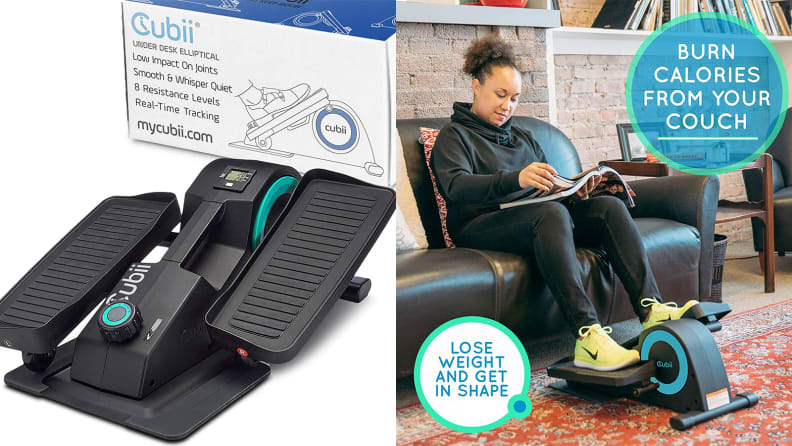
No, you can't get fit while sitting on the couch.
For someone looking to maintain or improve their fitness from the comfort of their desk, I would say the Cubii Jr. is not worth it. Simply put, $250 is a lot to spend on a fitness product that may only get your heart rate up to a walking heart rate, if your experience is anything like mine. I understand the appeal of incorporating “unconscious” exercise into your routine, and perhaps if you’re better at multitasking than I am and you use it every day (and you don't find the movement awkward), you could argue that it pays for itself. That said, I don’t feel the results pay for it, when you could get more physical (and psychological) benefits from taking brief work breaks to go for a walk.
I chatted with editor-slash-trainer Amy Roberts to understand more about the fundamentals of fitness and why the Cubii fell flat for me. “This motion doesn’t translate to any movement that we do in life, making it not the most ‘functional,’” she says. “You could get better and better at this, but not see any huge improvement in, say, your ability to walk long distances, because it doesn’t tax the muscles in the same way.”
Essentially, even if you get really great at the Cubii—and eventually you will run out of ways to push yourself because you’ll reach the highest resistance and speed the machine allows—this “training” will not translate over into your real life when you need to climb a long flight of stairs or lift something heavy. And its limited heart-rate raising effects mean that using Cubii as “cardio” won’t likely improve your aerobic stamina, either.
Of course, I have no current injuries or other physical limitations. It’s possible this product may be an appropriate rehabilitation tool in some cases. But if that’s what you’re after, we suggest you speak to your physician about whether the Cubii Jr. can help you achieve your goals before you fork over the cash.

